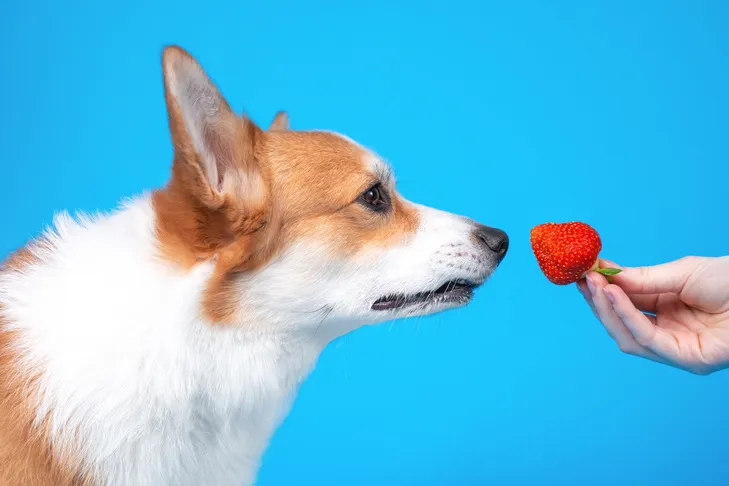It’s natural to want to share your favorite snacks with your beloved canine companion, but a dog’s digestive system is vastly different from a human’s. What may be a healthy treat for you could be toxic or harmful to your dog. Understanding which human foods are safe and which are dangerous is critical for every pet owner, especially when it comes to fruits. While some fruits offer beneficial vitamins and antioxidants, others contain compounds, seeds, or parts that are downright toxic, leading to severe health problems or even life-threatening emergencies.
This comprehensive guide from Dog Care Story will help you navigate the world of fruits and identify what human food dogs can eat and, more importantly, which fruits your dog should never, ever consume. Prioritizing your dog’s safety and well-being means being informed about the potential dangers lurking in your fruit bowl.
Understanding Why Certain Fruits Are Dangerous for Dogs
Dogs, though omnivores, have different metabolic processes and sensitivities than humans. Their bodies may struggle to process certain compounds that are harmless to us, or these substances might even be highly toxic. The dangers in fruits can range from causing mild gastrointestinal upset to severe organ damage, choking hazards, or even cyanide poisoning. It’s not just about the flesh of the fruit; pits, seeds, stems, and leaves can also contain dangerous substances.
Always remember that even safe fruits should be given in moderation as treats, not as a primary food source, and always properly prepared to remove any dangerous parts.
Fruits Dogs Should ABSOLUTELY Avoid
When it comes to your dog’s diet, some fruits are strictly off-limits due to their toxic properties or inherent dangers. Keeping these fruits out of your dog’s reach is non-negotiable for their health and safety.
Avocado
While a popular superfood for humans, avocado should never be given to dogs. The pit, skin, and leaves of avocados contain a fungicidal toxin called persin. This substance can cause vomiting and diarrhea in dogs, and in higher quantities, it may lead to more severe gastrointestinal distress. Although the fleshy part of the avocado contains less persin, the risk of upset stomach or other issues makes it best to avoid entirely.
Furthermore, avocado is very high in fat. Consuming too much fat can lead to gastrointestinal upset and, more seriously, pancreatitis in dogs, a painful and potentially life-threatening inflammation of the pancreas. The large pit also poses a significant choking hazard and can cause an intestinal obstruction if swallowed.
Cherries
With the exception of the pulp around the seed, all parts of the cherry plant – including the stems, leaves, and especially the pits – contain cyanide. Cyanide is a potent toxin that disrupts cellular oxygen transport, meaning your dog’s blood cells cannot get enough oxygen. If a dog consumes cherries whole or chews on cherry pits, they are at risk of cyanide poisoning.
Symptoms of cyanide poisoning can appear quickly and include:
- Dilated pupils
- Difficulty breathing
- Red gums
- Shock
This is a veterinary emergency. If you have cherry trees in your yard, ensure your dog does not have access to fallen fruit. Always discard cherry pits securely in a dog-proof trash bin, and educate children about the dangers of sharing cherries (and their pits) with your dog.
Grapes and Raisins
Perhaps one of the most notoriously toxic fruits for dogs, grapes and raisins pose a severe threat, regardless of the dog’s breed, sex, age, or health status. The exact toxic substance is still unknown, but even small quantities can lead to acute sudden kidney failure. This makes grapes and raisins incredibly dangerous, and consumption should always be treated as a veterinary emergency.
If you suspect your dog has eaten any amount of grapes or raisins, contact your veterinarian immediately. Do not wait for symptoms to appear. Keep all grape and raisin products, including baked goods containing them, well out of your dog’s reach. Be mindful of snack-time mishaps, especially if children are present, and ensure compost or trash bins containing these fruits are inaccessible to your dog. What fruits are dogs not allowed to eat often includes this at the very top of the list.
Tomatoes (Green Parts)
While the ripe red flesh of a tomato is generally considered safe for dogs in very small amounts, the green parts of the tomato plant – including the leaves, stems, and unripe green tomatoes – contain a toxic substance called solanine. In large quantities, solanine can be harmful to dogs, causing symptoms like gastrointestinal upset, lethargy, weakness, and loss of coordination.
While a dog would likely need to consume a significant amount of the green plant material to become seriously ill, it’s safer to err on the side of caution and avoid feeding tomatoes altogether. If you have a vegetable garden, take steps to prevent your dog from accessing tomato plants to minimize any risk.
 A calm Rottweiler lying in a green yard with its head tilted, signifying a dog's cautious approach to unknown plants and fruits.
A calm Rottweiler lying in a green yard with its head tilted, signifying a dog's cautious approach to unknown plants and fruits.
Other Fruits to Exercise Caution With
Beyond the definitively toxic fruits, there are other fruits that, while not inherently poisonous, require careful consideration due to specific components or their nutritional profile. These aren’t “should not eat” in the same absolute sense, but they come with significant caveats.
Fruit Pits and Seeds
A common danger across many otherwise safe fruits is their pits and seeds. These can pose two main risks:
- Choking Hazard & Intestinal Blockage: Large pits from fruits like peaches, mangoes, plums, and apricots can become lodged in your dog’s throat or cause a dangerous blockage in their digestive tract if swallowed.
- Cyanide Content: The seeds of apples and pears, and the pits of apricots, cherries, and plums, contain small amounts of naturally occurring cyanide. While one or two seeds might not cause immediate harm, ingestion of larger quantities or regular consumption can lead to a buildup of toxins.
Always ensure all pits and seeds are completely removed before offering any fruit flesh to your dog.
High Sugar Content
Many fruits, even healthy ones, are naturally high in sugar. While natural sugars are better than processed ones, excessive intake can be detrimental to your dog’s health, leading to:
- Weight Gain and Obesity: Extra calories contribute to weight gain, which can exacerbate joint problems and lead to other health issues.
- Diabetes: Dogs, like humans, can develop diabetes, and a diet high in sugar can be a contributing factor or worsen existing conditions.
- Gastrointestinal Upset: Too much sugar can cause diarrhea or an upset stomach in sensitive dogs.
Fruits like bananas, mangoes, cantaloupe, and even strawberries, while safe in moderation, should be given sparingly due to their sugar content. This is especially true for dogs who are overweight or have a predisposition to diabetes.
Citrus Peels and Strong Scents
Fruits like oranges are technically safe for dogs to eat in small amounts, but only the juicy flesh. The peels of citrus fruits are often tough, difficult to digest, and contain oils that can cause gastrointestinal upset or irritation. Many dogs are also naturally turned off by the strong smell and taste of citrus. While not overtly toxic, the risks of digestive issues make it a fruit to approach with caution, focusing only on small, peeled, seedless portions if your dog shows interest.
Safe Fruits for Dogs (In Moderation)
While the focus is on What Fruits Dogs Should Not Eat, it’s also helpful to know which fruits can be safely offered as an occasional, healthy treat. Remember, always prepare them correctly by removing pits, seeds, and rinds, and offer only in small quantities. For a complete guide to various foods, refer to our article on what fruits and vegetables should dogs not eat.
- Apples: A great source of vitamins A and C, and fiber. Always remove the core and seeds.
- Bananas: High in potassium, vitamins, and fiber, but also high in sugar. Offer in small slices.
- Blueberries: A superfood packed with antioxidants, fiber, and phytochemicals. Great for training treats.
- Cantaloupe: Low in calories, good source of water and fiber, but high in sugar. Give in moderation.
- Cranberries: Both fresh and dried (unsweetened) are safe in small quantities. Known for urinary tract benefits.
- Cucumbers: Excellent for overweight dogs, very low in calories, and full of hydration, vitamins K, C, B1.
- Mango: Rich in vitamins A, B6, C, and E, as well as potassium. Remove the pit thoroughly due to cyanide and choking hazard. High in sugar.
- Oranges: Only the flesh, no peel or seeds, in small amounts. Good source of Vitamin C.
- Peaches: Fresh or frozen, without the pit (contains cyanide). A good source of fiber and vitamin A. Avoid canned peaches with sugary syrup.
- Pears: High in copper, vitamins C and K, and fiber. Remove core and seeds. Avoid canned pears.
- Pineapple: Chunks of fresh pineapple (no prickly peel or crown). Rich in vitamins, minerals, and bromelain for protein absorption. Avoid sweetened canned pineapple.
- Pumpkin: Pure pumpkin puree (not pie filling!) is excellent for digestive health, rich in antioxidants and fiber. Can help with both diarrhea and constipation.
- Raspberries: Safe in moderation, low in sugar, high in fiber, manganese, and vitamin C. They contain small amounts of xylitol, so limit consumption to no more than 8 ounces. Beneficial for senior dogs due to anti-inflammatory properties.
- Strawberries: Full of fiber and vitamin C, and contain an enzyme that can help whiten teeth. Offer in moderation due to natural sugar content.
- Watermelon: A hydrating treat (92% water) packed with vitamins A, B-6, and C, and potassium. Always remove the rind and seeds to prevent intestinal blockage.
 A cute Pembroke Welsh Corgi inquisitively sniffing a ripe strawberry, demonstrating a dog's interest in safe fruit snacks.
A cute Pembroke Welsh Corgi inquisitively sniffing a ripe strawberry, demonstrating a dog's interest in safe fruit snacks.
What About Vegetables?
While this article primarily focuses on fruits, it’s important to briefly touch upon vegetables as they often appear alongside fruits in discussions about human foods for dogs. Just like fruits, some vegetables are safe and even beneficial for dogs, while others can be toxic or harmful.
For a detailed list of safe and unsafe vegetables, refer to our specific guide on what veggies should dogs not eat. Generally, many leafy greens and root vegetables can be good sources of fiber and nutrients. For example, carrots are a great low-calorie snack, and pumpkin (technically a fruit but often categorized as a vegetable) is excellent for digestion.
When considering vegetables, always ensure they are plain, cooked if necessary for digestibility (e.g., broccoli florets, avoiding tough stalks), and free from any added seasonings, onions, or garlic, which are toxic to dogs. If you’re looking for what high fiber foods can dogs eat, many safe vegetables are excellent options.
Conclusion
Navigating the world of human foods for your dog, especially fruits, requires diligence and knowledge. While sharing a healthy, dog-safe fruit can be a wonderful way to bond and provide nutritional boosts, being aware of what fruits dogs should not eat is paramount to preventing serious health issues. Always remember that what’s safe for humans isn’t always safe for our furry friends.
Prioritize your dog’s health by always researching before introducing new foods, removing all dangerous parts like pits and seeds, and offering new treats in strict moderation. When in doubt, it’s always best to consult with your veterinarian before feeding your dog any new human food. They can provide tailored advice based on your dog’s specific health needs and dietary requirements. Stay informed, stay vigilant, and keep your beloved canine companion safe and healthy!
